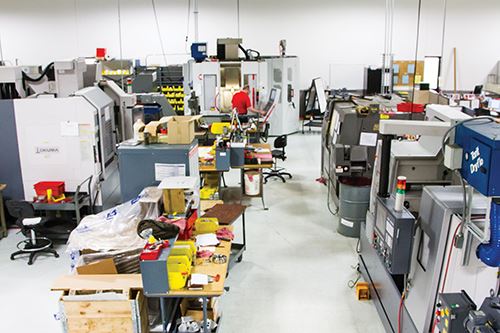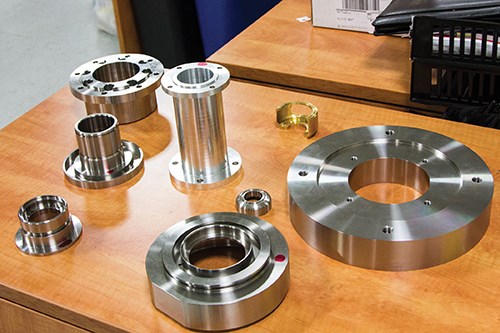Aztalan Aims for Rapid Adjustment
Aztalan Engineering shortened its lead times by switching to a short-run cell model for its prototype jobs and implementing a company-wide QRM strategy.
Share


.png;maxWidth=45)
DMG MORI - Cincinnati
Featured Content
View More



Autodesk, Inc.
Featured Content
View MoreWhen Aztalan Engineering in Lake Mills, Wisconsin, started searching for ways to differentiate itself from its competitors while shortening lead times, the company had to look no further than its own shop floor. It grouped four machines that were already being used for long-term production runs into a dedicated short-run rapid prototyping cell that became the key to a Quick Response Manufacturing (QRM) strategy. This initiative has set in motion a company-wide mindset that President and CEO Dirk Maroske says will be critical to the company’s success as customers demand leaner and leaner operations from shops like his.
As productivity increases year over year, shorter and shorter lead times are being expected, Mr. Maroske says. “That has basically driven our initiative with QRM and lean down to the shortest possible lead times.”
Since its founding in 1978, Azatlan has operated as a traditional contract manufacturer, with longer-run jobs contributing significantly to the business, which is about 90 percent dominated by the medical device industry. Seventy employees work in its two buildings—the original 30,000-square-foot shop and the 46,500-square-foot shop built in 2010—turning out high-precision parts from materials including aluminum, brass, stainless steel and titanium.
The launch of the short-run cell essentially marked the company’s move from standard manufacturing in which a part is moved from station to station across a shop’s floor, to cellular manufacturing. The adjustment of using the cells for shorter and shorter part runs created a lot of pressure on the shop floor, Mr. Maroske says. The challenge, he says, was to quickly program machining of the parts and then get them on the machines.
“Before, we couldn’t get a part from the computer, into material and off the machine quickly enough,” says Jeff Harland, lead programmer. “We had production parts on all the machines, and fitting new parts on a machine was a challenge.”
To build its short-run cell, Aztalan moved four machines that once stood across the shop floor from each other into a U-shaped configuration in the middle of the floor. These machines include a Hardinge Conquest super-precision, single-spindle lathe with a single turret; an Okuma LB3000EX; a five-axis Hermle milling center; and an Okuma Genos M460 vertical mill. Now, the company uses the machines as a mechanized team, trying to coordinate job features so that the machines can complement each other.
Recently, the company was able to complete an order for 10 different parts in about a week and a half for a new customer. The parts demanded much higher tolerances than the shop’s usual 0.0003 inch, but Aztalan was able to dedicate the cell to the task, and the customer has since ordered more of those parts.
The manufacturing cell uses the Okuma M460 as its workhorse, capable of producing various part features quickly. For a recent job involving a stainless steel part with a variety of holes, Mr. Harland says the hole pattern was programmed in 15 minutes and then the part was machined on the M460 in one hour.
The cell also uses Esprit software from DP Technology, which enables the company to import almost any design file from any software package and prove out the part virtually. Technology such as this enables shops to dramatically reduce prove-out times, Mr. Maroske says, especially when they are running very complex parts on multi-axis machines. Aztalan had the good fortune of investing in this technology several years ago, so its programmers—including, Mr. Harland and colleague Jim Astell, who works primarily on the Hermle—are experienced in using it for the short-run cell.
The Hermle five-axis milling center provides machining agility that the other three machines in the cell simply cannot. For example, when the shop is running aluminum parts for medical devices, the Hermle’s spindle runs at 18,000 rpm, enabling high-speed machining and giving the cell most of its quick-run capability.
Machinist Dean Kassube, who runs all the machining on the Hermle, notes that, although the machine been on Aztalan’s shop floor for more than three years, the company has only scratched the surface of its capabilities. He and Mr. Astell have worked together closely during that time, learning how to get the most from the machine. The ultimate goal is to get parts in, on and out of the machine as fast as possible, achieving the highest possible level of quality.
The short-run cell has helped the rest of Aztalan’s operation implement the QRM initiative more effectively as well. No longer does the company have to interrupt longer production runs with tooling change-outs, new programs and different fixtures just to produce five parts for a new customer. Now, those shorter runs have a dedicated space, and the company’s 28 other machines can do what they do best.
For example, Aztalan recently needed to machine 24 fairly complex parts that then had to be sent out for plating. The company received the designs on a Friday and delivered finished parts to the customer the following Thursday. The parts were produced on horizontal mills, but what made the difference in getting those parts out the door on time was yet another of the company’s QRM-based initiatives—reducing its batch sizes. In the past, Megan Patterson, QRM project manager, says Aztalan routinely ran large lots on its twin-spindle turning centers. It might run as many as 800 3-foot bars even though the order was for only 200 pieces. This meant the company immediately had 600 pieces of inventory sitting on its shelves. Not only that, but Aztalan also was tying up those machines for long stretches of time that could be better segmented to serve multiple customers.
One immediate benefit of QRM was a reduction in inventory. “In the first year of implementing smaller batch sizes, we actually took down our finished-goods inventory by over $1 million,” Ms. Patterson says. “It was a huge win for us.”
That mindset translated directly to the short-run cell as well. Whereas the shop once used the five-axis Hermle for runs of 50 to 200 pieces, now that machine typically hosts production runs of no more than 20 pieces.
The cell also increases efficiency in the quality control area, where Quality Technician Tom Flood must ensure tolerances to 0.0005 inch, with tight positional callouts to boot. On short runs of one or two parts, Mr. Flood often does the CMM work manually to save time. During tight production schedules, having the short-run cell machines together and close to his glass-enclosed CMM area helps tremendously.
“We’re trying not to scrap parts out, so the programmers and the machinists are trying to get tolerances as close as they can right away,” Mr. Flood says. “There’s a lot of double-checking back and forth, a lot of communication between the machinists and the programmer and myself.
“Having the cell close is absolutely an advantage. If they’re turning a part on the chuckers [lathes] and then it goes to the Hermle or the VMC for secondary operations, having them right next to each other is a huge time-saver.”
Between the company’s ability to quickly turn around high-quality prototypes and short-run parts and the QRM culture, Aztalan is positioning itself well now and in the future, Mr. Maroske says.
“If you are very, very fast, it’s not always about prices,” Mr. Maroske notes. “In the segment that we are in—precision machining, with very tight tolerances—it’s a little bit more expensive. When the buyer has to buy, say, custom-engineered products, they typically are already late when they get the request for purchase. Then they basically reach out to their supply chain. And then who do you go with? The ones who can turn it around right away.”
Read Next
5 Rules of Thumb for Buying CNC Machine Tools
Use these tips to carefully plan your machine tool purchases and to avoid regretting your decision later.
Read MoreBuilding Out a Foundation for Student Machinists
Autodesk and Haas have teamed up to produce an introductory course for students that covers the basics of CAD, CAM and CNC while providing them with a portfolio part.
Read MoreRegistration Now Open for the Precision Machining Technology Show (PMTS) 2025
The precision machining industry’s premier event returns to Cleveland, OH, April 1-3.
Read More



































.png;maxWidth=300;quality=90)
















.png;maxWidth=970;quality=90)